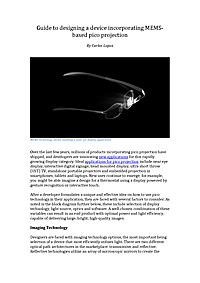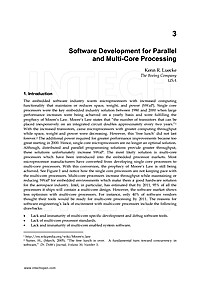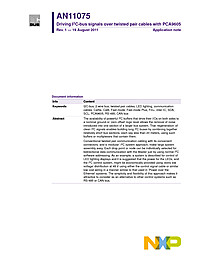

Guide to designing a device incorporating MEMS-based pico projection
Over the last few years, millions of products incorporating pico projection have shipped, and developers are innovating new applications for this rapidly growing display category. Ideal applications for pico projection include near eye display, interactive digital signage, head mounted display, ultra short throw (UST) TV, standalone portable projectors and embedded projection in smartphones, tablets and laptops. New uses continue to emerge; for example, you might be able imagine a design for a thermostat using a display powered by gesture recognition or interactive touch.

Software Development for Parallel and Multi-Core Processing
The embedded software industry wants microprocessors with increased computing functionality that maintains or reduces space, weight, and power (SWaP). Single core processors were the key embedded industry solution between 1980 and 2000 when large performance increases were being achieved on a yearly basis and were fulfilling the prophecy of Moore's Law. Moore's Law states that "the number of transistors that can be placed inexpensively on an integrated circuit doubles approximately every two years." With the increased transistors, came microprocessors with greater computing throughput while space, weight and power were decreasing. However, this 'free lunch' did not last forever. The additional power required for greater performance improvements became too great starting in 2000. Hence, single core microprocessors are no longer an optimal solution.

Driving I2C-Bus Signals Over Twisted Pair Cables with PCA9605
The availability of powerful I2C buffers that drive their I/Os on both sides to a nominal ground or ‘zero offset’ logic level allows the removal of noise introduced into one section of a larger bus system. That ‘regeneration’ of clean I2C signals enables building long I2C buses by combining together relatively short bus sections, each say less than 20 meters, using such buffers or multiplexers that contain them. Conventional twisted pair communication cabling with its convenient connectors, and a ‘modular’ I2C system approach, make large system assembly easy. Each drop point or node can be individually selected for bidirectional data communication with the Master just by using normal I2C software addressing. As an example, a system is described for control of LED lighting displays and it is suggested that the power for the LEDs, and the I2C control system, might be economically provided using ‘extra low voltage’ distribution at 48 V using either the control signal cable or similar low cost wiring in a manner similar to that used in ‘Power over the Ethernet’ systems. The simplicity and flexibility of this approach makes it attractive to consider as an alternative to other control systems such as RS-485 or CAN bus.
Embedded Systems – Theory and Design Methodology
This book addresses a wide spectrum of research topics on embedded systems, including basic researches, theoretical studies, and practical work.
Embedded Systems – Theory and Design Methodology
This book addresses a wide spectrum of research topics on embedded systems, including basic researches, theoretical studies, and practical work.

Driving I2C-Bus Signals Over Twisted Pair Cables with PCA9605
The availability of powerful I2C buffers that drive their I/Os on both sides to a nominal ground or ‘zero offset’ logic level allows the removal of noise introduced into one section of a larger bus system. That ‘regeneration’ of clean I2C signals enables building long I2C buses by combining together relatively short bus sections, each say less than 20 meters, using such buffers or multiplexers that contain them. Conventional twisted pair communication cabling with its convenient connectors, and a ‘modular’ I2C system approach, make large system assembly easy. Each drop point or node can be individually selected for bidirectional data communication with the Master just by using normal I2C software addressing. As an example, a system is described for control of LED lighting displays and it is suggested that the power for the LEDs, and the I2C control system, might be economically provided using ‘extra low voltage’ distribution at 48 V using either the control signal cable or similar low cost wiring in a manner similar to that used in ‘Power over the Ethernet’ systems. The simplicity and flexibility of this approach makes it attractive to consider as an alternative to other control systems such as RS-485 or CAN bus.

Software Development for Parallel and Multi-Core Processing
The embedded software industry wants microprocessors with increased computing functionality that maintains or reduces space, weight, and power (SWaP). Single core processors were the key embedded industry solution between 1980 and 2000 when large performance increases were being achieved on a yearly basis and were fulfilling the prophecy of Moore's Law. Moore's Law states that "the number of transistors that can be placed inexpensively on an integrated circuit doubles approximately every two years." With the increased transistors, came microprocessors with greater computing throughput while space, weight and power were decreasing. However, this 'free lunch' did not last forever. The additional power required for greater performance improvements became too great starting in 2000. Hence, single core microprocessors are no longer an optimal solution.

Guide to designing a device incorporating MEMS-based pico projection
Over the last few years, millions of products incorporating pico projection have shipped, and developers are innovating new applications for this rapidly growing display category. Ideal applications for pico projection include near eye display, interactive digital signage, head mounted display, ultra short throw (UST) TV, standalone portable projectors and embedded projection in smartphones, tablets and laptops. New uses continue to emerge; for example, you might be able imagine a design for a thermostat using a display powered by gesture recognition or interactive touch.




















